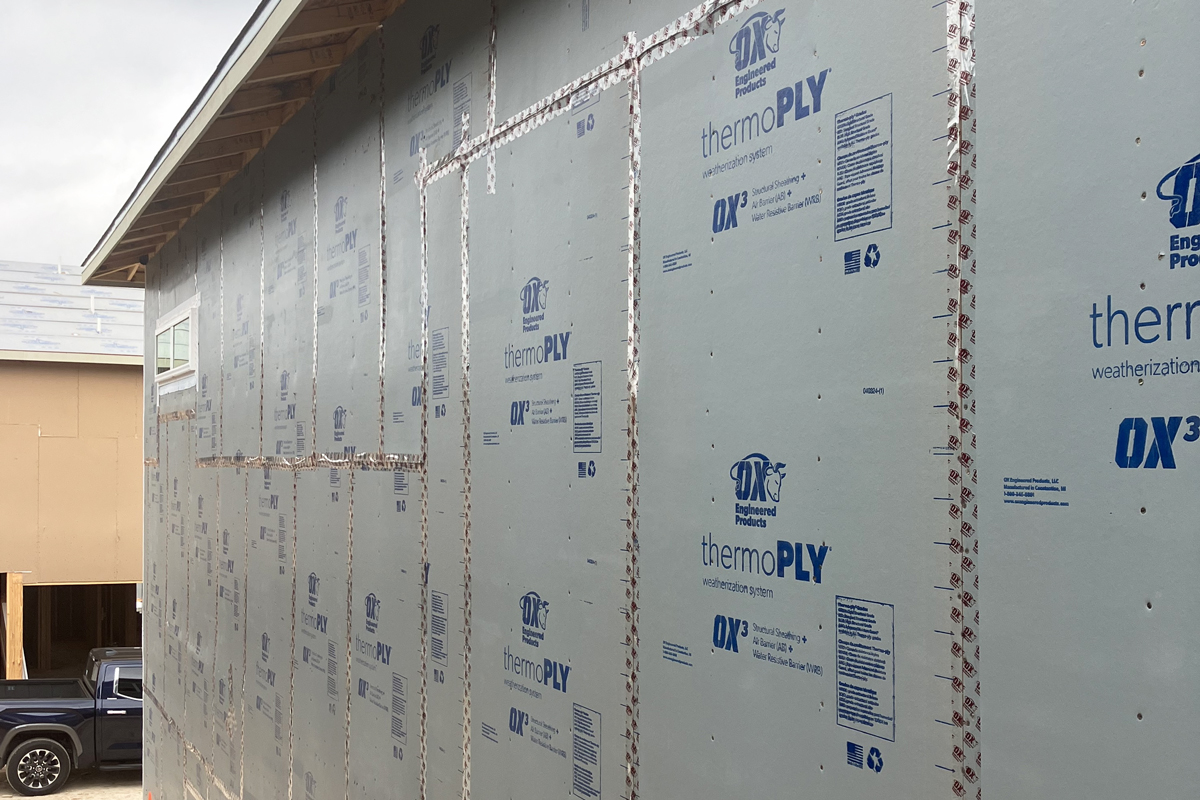CONTACT OX
TO LEARN MORE
Give us a call at 800-345-8881 or fill out the form below
and we’ll get back to you within two business days.

People often say “out of sight, out of mind,” but that shouldn’t be the mantra when it comes to sheathing. Sheathing may be hidden beneath the exterior finish, but it plays a critical role in building envelope performance. Acting as both a stabilizer and a shield, it reinforces the structure while defending against wind and the elements.
Still, not all sheathing is created equal.
Climate conditions, code requirements, structural needs, and energy goals all have an influence on which sheathing is the right choice. Builders, architects, and developers must balance performance, cost, and system compatibility to ensure the sheathing supports the design and long-term durability of the project.
Composition: ThermoPLY vs. OSB
ThermoPly is an integrated sheathing material that sets itself apart from tradition OSB. Manufactured using high-strength cellulosic fibers that are bonded with a protective polymer layer, ThermoPLY is lightweight, slim, and highly resistant to moisture. Its composition allows for easier handling on the job site and reduces the overall load on a building’s frame, making it an appealing choice for projects where efficiency and durability are priorities.
While ThermoPly and OSB are both structural wall sheathing, their composition is a big differentiator. ThermoPly is manufactured using high-strength cellulosic fibers that are bonded with a protective polymer layer. This process produces a panel that is not only lightweight and slim but also highly resistant to moisture and environmental stress. Its composition allows for easier handling on the job site and reduces the overall load on a building’s frame, making it an appealing choice for projects where efficiency and durability are priorities.
OSB is composed of wood strands arranged in layers and pressed together with adhesives to form a thick, rigid, and dense board. It provides excellent structural stability and load-bearing capability, but it is a sole material that does not include any weather-resistant properties.
Weight & Handling: Lighter Loads, Faster Progress
ThermoPLY and OSB differ significantly in terms of weight and ease of installation. A 4×8 sheet of ThermoPLY weighs in at just about 13 pounds, less than half the weight of a typical OSB panel, which comes in at approximately 46–48 pounds. ThermoPLY’s reduced heft makes it a breeze to lift, carry, and maneuver on the jobsite, minimizing the physical strain on crews and making installations move faster. OSB, by comparison, is noticeably heavier, requiring more effort to handle and potentially slowing progress, especially on projects where speed and efficiency are key.
Skip the Wrap, Keep the Strength
ThermoPLY’s polymer-laminated surface gives it natural resistance to water, preventing swelling, warping, or delamination even in damp or humid conditions. Its moisture-resistant properties also allow it to act as an air and water barrier when seams are properly sealed.
OSB, by comparison, is more susceptible to moisture damage because it is made from real wood. Extended exposure to water or high humidity can lead to swelling, warping, and edge expansion. Therefore, once installed, OSB needs added protection like housewrap or coatings to maintain the integrity of the exterior wall. While both ThermoPLY and OSB can provide strong, durable walls when installed properly, ThermoPLY’s built-in moisture resistance eliminates the need for additional weatherproofing layers.
From Weather to Workflow: Picking the Perfect Sheathing
Sheathing may be hidden, but choosing the right product has a lasting impact on performance, durability, and the installation process.
The deciding factors lie in a project’s specific needs. Climate, structural requirements, budget constraints, and project timelines all play a factor. By thoughtfully considering each element, builders, architects, and developers can choose the sheathing that delivers not only a strong, resilient structure, but also long-lasting protection that stands the test of time against Mother Nature.
